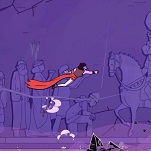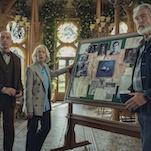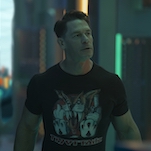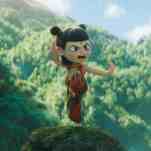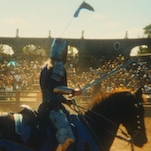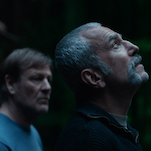The games of Fumito Ueda have a contentious relationship with technology. The loose trilogy of dreamy, atmospheric adventure games he created for Sony—2001’s Ico, 2005’s Shadow Of The Colossus, and 2015’s The Last Guardian—are noted for their minimalist narratives and painterly visual design, full of sun-baked ruins and ghostly fog. But they might as well be known for the way they seem to wrench the life out of the systems on which they run, like some sort of spectral deity briefly possessing them. Ico was designed for the original PlayStation before it was moved to Sony’s much more powerful successor. Shadow Of The Colossus famously wrung every ounce of power from that system, creating massive monsters that the player interacted with and clambered over. Ueda spent years trying to make The Last Guardian work on Sony’s PlayStation 3 before the game fell into limbo and was miraculously revived on the PlayStation 4 nearly a decade after its development began, and even on that system you can see it croaking under the weight of his ambition. When the game’s dog-bird creature, full of lifelike animations and individually fluttering feathers, wanders into a thicket of trees, each branch of which sways realistically in the breeze, you can hear the system screaming in agony. Mine sounded like a lawnmower when I played it.
But there were other concerns, too. Shadow Of The Colossus is a game of a single, Goliath-slaying narrative, repeated 16 times, and the height of each miniature drama is the time spent crawling across these monsters as they stomp and shake and writhe in the sky. Ueda has an impressionistic attitude toward controls; Wander takes these big flighty jumps and dangles off the colossi, sometimes for prolonged stretches. This lacks the immediacy of many modern big-budget games, but adds immeasurably to the sense of slow-build tension the game creates. “Updating” the controls could ruin the operatic grandeur of these encounters.
This all washed away once I finally got back out in the field, the camera settling in far to my side and the familiar gray skies of the Forbidden Land stretching out in front of me. The game’s acolytes, who have traced every inch of its landscape and even journeyed far outside it, spelunking through abandoned patches of code, are already producing doctoral theses comparing locations from the two versions of the game, but the net effect is reassuringly similar. The designers at Bluepoint have done more than merely honor the spirit of the game; they have built upon it. Their investment in quality of light creates a milkier morning hue and more somber overcast sky. The draw distance creates eye-popping moments that bring the scale of the world into greater relief, like the way a quiet journey across a rocky bridge now provides a haunting view of waterfalls seemingly miles in the distance. A descent into an underground cavern feels even murkier when the rain-slicked tiles at the bottom seem almost tactile as you find footholds. The handful of mechanical shifts—like a gingerly implemented auto-save feature—seem placed reverently, as if marking off a path for visitors on sacred ground.
In a way, they are. SOTC is Ueda’s singular masterpiece, lacking some of the foundling awkwardness of Ico or the sense of compromise that plagues The Last Guardian. A decade later and totally remade, it’s still a game of gobsmacking, devastating beauty, with moments and images that haunt you long afterward: Wander’s physical deterioration, the violent spurts of black blood from a colossus’ head, the compromised canter of an old friend as the game draws toward its mythic conclusion. All of its pieces hold up—even now, when its influence is most often touted to describe any old game with “big boss fights,” and Nintendo, of all companies, has realized its unlikely successor in The Legend Of Zelda: Breath Of The Wild. Bluepoint set out to make the definitive version of the game—a bold, almost heretical ambition for one of the most richly imagined and executed works in the medium—and it has succeeded.
This suggests, at the very least, a rethinking in how best to preserve culturally important video games. For a long time the thinking among “retro gamers” has been to play them in their original contexts, with their original controls and controllers and TV fidelities. This has always made sense to me. It’s how we strive to view many pieces of art, whether by enjoying the analog warmth of music on vinyl, the rich colors of 35mm film, or the tirelessly preserved colors of paintings. In the past decade, many games have been remastered to run on high-definition screens with mixed results; Bluepoint itself has contributed a handful of well-done HD remasters, including work on Ueda’s first two games in 2011. In the wrong hands, though, HD remasters can ruin the source material—Silent Hill’s collection notoriously turned the game’s signature fog into big sheets of semi-transparent white noise—but in general, they’re a solid step toward making classic games playable on modern systems and television sets.
But is availability all that matters? Just as hardware advances over time, so too do design principles and user-experience standards, and games, unlike film, paintings, or music, must be interacted with. Much has been made of, say, Dark Souls’ “old school” difficulty, which was indeed iconoclastic, but the game still featured liquid-smooth combat, byzantine graphical flourishes, and many modern design conveniences, like automatic saving. Its difficulty was focused and intentional. Shadow Of The Colossus is far from a difficult game, but there was a prickliness to its interface and the way we interacted with it that’s been smoothed over in the 2018 version. Wander wanders with a little more clarity to his movements, jumping the way you want him to. As for the visual concerns, Bluepoint takes few liberties, letting the camera drink things in more sweetly and peppering a few rocks into a field that only looks more barren for their presence. And there’s a sense of playfulness to many of the superfluous additions, encouraging you to get your hands dirty with the game—digging into your stats, taking photos of your exploits, toggling minor annoyances and embellishments off and on. None of them have any huge impact—you can turn off the ham-fisted “hint” system from the original version, for example—but the net effect is a more approachable and playable experience.
There is some precedent for this. In 2002, Shinji Mikami remade his iconic 1996 game Resident Evil from the ground up, resulting in an altogether different game that nevertheless stands up admirably to its predecessor—eerie where the first was goofy, sumptuous where the first was jagged. And numerous fan communities have sought to bring iconic games into modern design precepts, most notably Black Mesa, a fan remake of Half-Life that is set for an official distribution by original publisher Valve, and the ongoing attempts to recreate old Elder Scrolls games using modern engines.
Anyone who has recently fired up the original Half-Life or Morrowind knows that experiencing those games as they were originally released is an eye-melting academic exercise that lasts an hour or two before you turn it off and go back to something new. The solution, at least as Bluepoint proposes in the SOTC remake, is a technical overhaul that treats the original mechanical design and artistic choices like the excavation of a precious artifact to be inspected, brushed off, preserved, and presented for public viewing. Games are the only medium for which a full-scale remake is the best method of preservation (sorry, Gus Van Sant), but that makes sense. Games are equal parts aesthetic and technical, and if the former can be honored while the latter is modernized, it may help that magical third ingredient—a player—experience it.
At least, that’s the case with the Shadow Of The Colossus remake. Whether other games would benefit from such treatment is up for debate, but it’s a more enticing prospect, to me at least, than grittier reboots. And anyway, any reason to reenter the Forbidden Land is a good one. If you have played the game many times, as I have, it’s worth a revisit. And if you have not, well, you have got one hell of a weekend ahead of you.


















